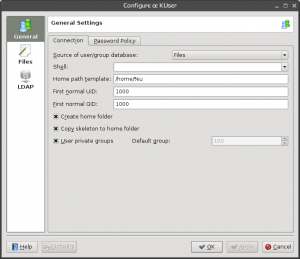KUser: Difference between revisions
Appearance
mNo edit summary |
Thiagosueto (talk | contribs) Propose deletion |
||
| (3 intermediate revisions by 3 users not shown) | |||
| Line 1: | Line 1: | ||
{{Proposed_deletion|reason=Unmaintained since 2016: https://invent.kde.org/unmaintained/kuser}} | |||
<languages /> | <languages /> | ||
<translate> | <translate> | ||
| Line 22: | Line 24: | ||
<!--T:6--> | <!--T:6--> | ||
'''KUser''' usually is not installed by default, so it has to be installed manually. '''KUser''' is part of the '''kdeadmin'''-package. | '''KUser''' usually is not installed by default, so it has to be installed manually. '''KUser''' is part of the '''kdeadmin'''-package. | ||
Once installed you can find it under <menuchoice> | Once installed you can find it under <menuchoice>Kickoff -> Applications -> System -> KUser</menuchoice> (<menuchoice>Kickoff -> System -> KUser</menuchoice> if you use the classic menu style) , or start it with '''KRunner''' (<keycap>Alt+F2</keycap>) typing {{Input|1=kuser}}. | ||
== Using KUser == <!--T:7--> | == Using KUser == <!--T:7--> | ||
| Line 40: | Line 42: | ||
<!--T:12--> | <!--T:12--> | ||
* Modify the user-properties like <menuchoice>User-ID</menuchoice>, <menuchoice>Name</menuchoice>, <menuchoice> | * Modify the user-properties like <menuchoice>User-ID</menuchoice>, <menuchoice>Name</menuchoice>, <menuchoice>Address information</menuchoice> or set/change a <menuchoice>password</menuchoice> for example. You can also <menuchoice>deactivate an account</menuchoice>. | ||
| Line 124: | Line 126: | ||
<!--T:36--> | <!--T:36--> | ||
*[http://docs.kde.org/stable/en/kdeadmin/kuser/ | *[http://docs.kde.org/stable/en/kdeadmin/kuser/index.html KUser Manual] | ||
<!--T:37--> | <!--T:37--> | ||
[[Category:System]] | [[Category:System]] | ||
</translate> | </translate> | ||
Latest revision as of 04:14, 1 March 2024
 |
KUser is a tool for managing users and groups on your system |
Features
- Add/Edit/Remove users
- Add/Edit/Remove groups
- Password Management
Setup
KUser usually is not installed by default, so it has to be installed manually. KUser is part of the kdeadmin-package.
Once installed you can find it under ( if you use the classic menu style) , or start it with KRunner (Alt+F2) typing
kuser
.
Using KUser
After starting KUser a window opens containing two tabs: and .

Users
Double-clicking a user opens a dialog with several tabs. The amount of tabs is variable, depending on the type of the user storage system and whether quotas are being used.
User Info
- Modify the user-properties like , , or set/change a for example. You can also .

Password Management
- Change password settings, like the time after which a password has to be changed, or set a time at which an account will expire.

Groups
- Add or remove groups the user belongs to.

Groups
Double clicking a opens a dialog, where you can of the group and to/from a group.

Configure KUser
Click and you can set up defaults for creating a new user:
General
- set the , the or the .
- choose if a will be created and if a (standard configuration files) will be copied to the home folder.
- set a , which creates a own personal group when a user is added and removes it, when the user is removed.
- set a .

Files
- set default paths for password, group file, password shadow file and group shadow file.

LDAP
- set preferences for users in a local network





